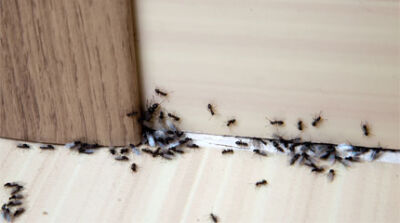METRO DETROIT — Every season has its drawbacks. One of summer’s biggest is the influx of insects. These buzzing creepy crawlies can drain the fun out of the best laid plans.
Household pests
Increased hot weather may be a factor in this. According to The Pest Dude, a pest control company, Michigan is set to have a warmer summer than average with equal rainfall.
“This combination is likely to lead to an increase in activity of the following pests in the state: cockroaches, ants, spiders, houseflies, bed bugs, centipedes, crickets and silverfish,” a press release from the company states.
The release explains that these findings came from analyzing data from climate.gov to see what insects are likely to be a problem in Michigan.
Sarah Hughson, an insect/arthropod diagnostician at Michigan State University, said bed bugs are mainly transported when traveling. She recommends checking the headboard and mattress with a flashlight where you’re staying for signs of bed bugs.
“You can do that by lifting up the sheets at the corners of the mattress and looking to see if you see any insects there,” she said.
She said that these insects are blood feeders and can become apparent from their droppings.
“If you see any brown speckling or staining around the edges of the mattress because that can indicate the bed bugs have been there,” she said.
Invasive species
Aside from these annoying bugs, there are also insects that can have a more harmful impact on Michigan’s environment. Invasive species include Asian long-horned beetle, balsam woolly adelgid, box tree moth, brown marmorated stink bug, emerald ash borer, hemlock woolly adelgid, Japanese beetle, mountain pine beetle, spongy moth and spotted lanternfly.
Hughson said the brown marmorated stink bug is a newer invasive species in Michigan. She said when seen, the bugs should be killed.
“They have a brown shield shaped body,” she said, describing the bug. “They have a reddish color eye and they’re going to have antennae that are white and brown striped.”
She said the bugs like tight crevices to hibernate during the winter. When the temperatures rise, they wake up to roam around.
Hughson recommends reporting invasive species, especially the Asian long-horned beetle and spotted lanternfly. These can be reported to the Department of Natural Resources or MSU’s plant and pest lab at msubughelp@msu.edu.
What to do if you get a tick
Ticks can be another common annoyance in Michigan that can carry disease, especially when traveling to more rural areas.
Hughson recommended not feeding deer since ticks can drop off into someone’s yard. She also said keeping woodpiles, which can be a hotspot for mice, away from a house can reduce ticks.
“With deer and mice being the preferred hosts for a lot of different types of ticks, those are just a couple of steps people can take to keep them further away from the house,” Hughson said.
Hughson said ticks like to be in places where clothes are tight to your body like waistbands. If a tick latches, she recommends using a pair of tweezers to pull it out.
“You want to make sure the inserted mouth part comes out with the tick,” she said.
Lighting a match and burning a tick isn’t a good method of removal, according to Hughson. She said this can cause the tick to regurgitate and not let go of its host.
“That can actually put you at a higher risk for a tick transmitted disease,” she said. “You really just want to gently pull those guys out and try not to break off the mouth part.”
She said wearing light colored clothes; tucking pants into socks; and spraying your shoes and ankle area with a repellent are all preventative measures against ticks.
 Publication select ▼
Publication select ▼






















